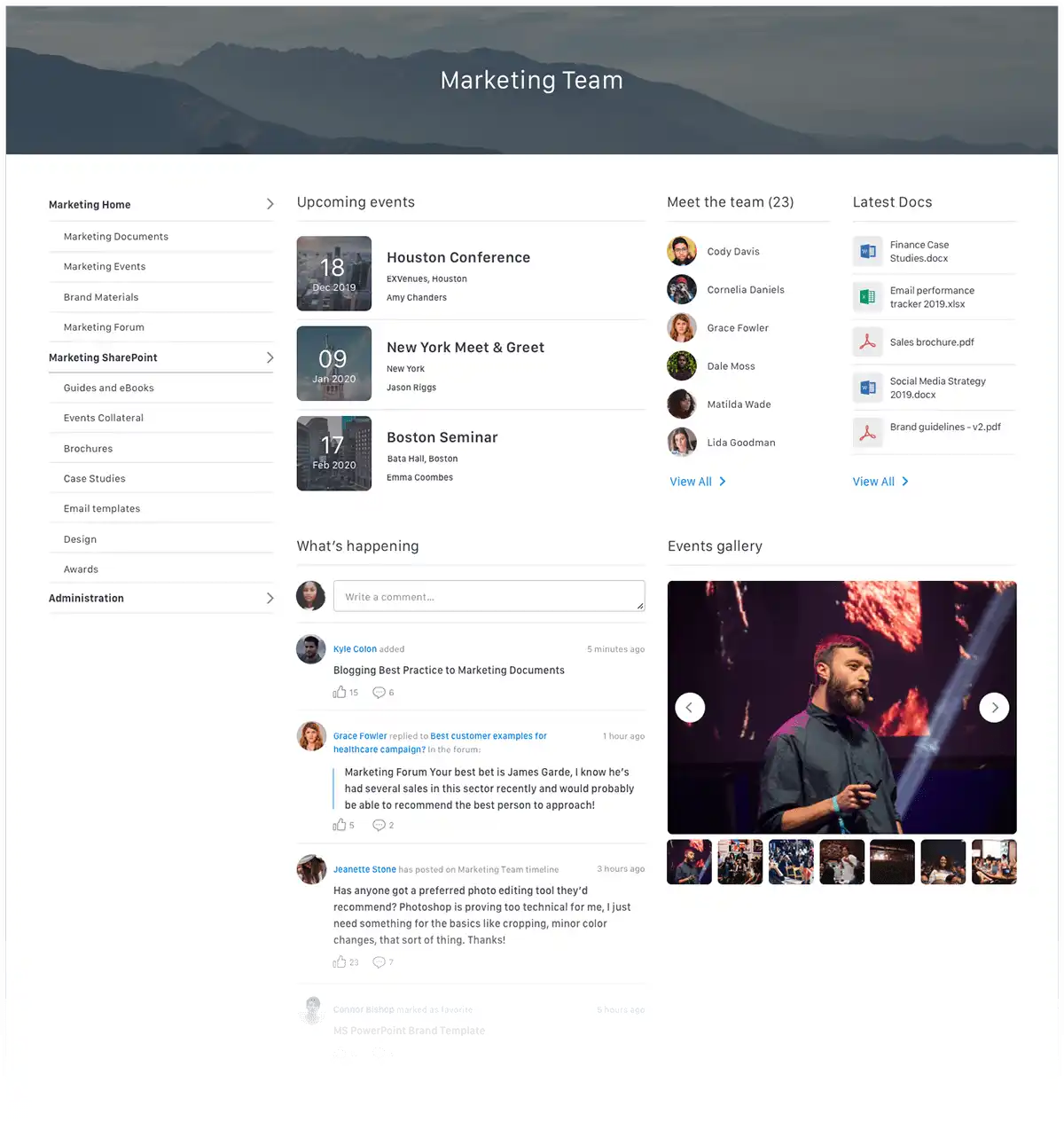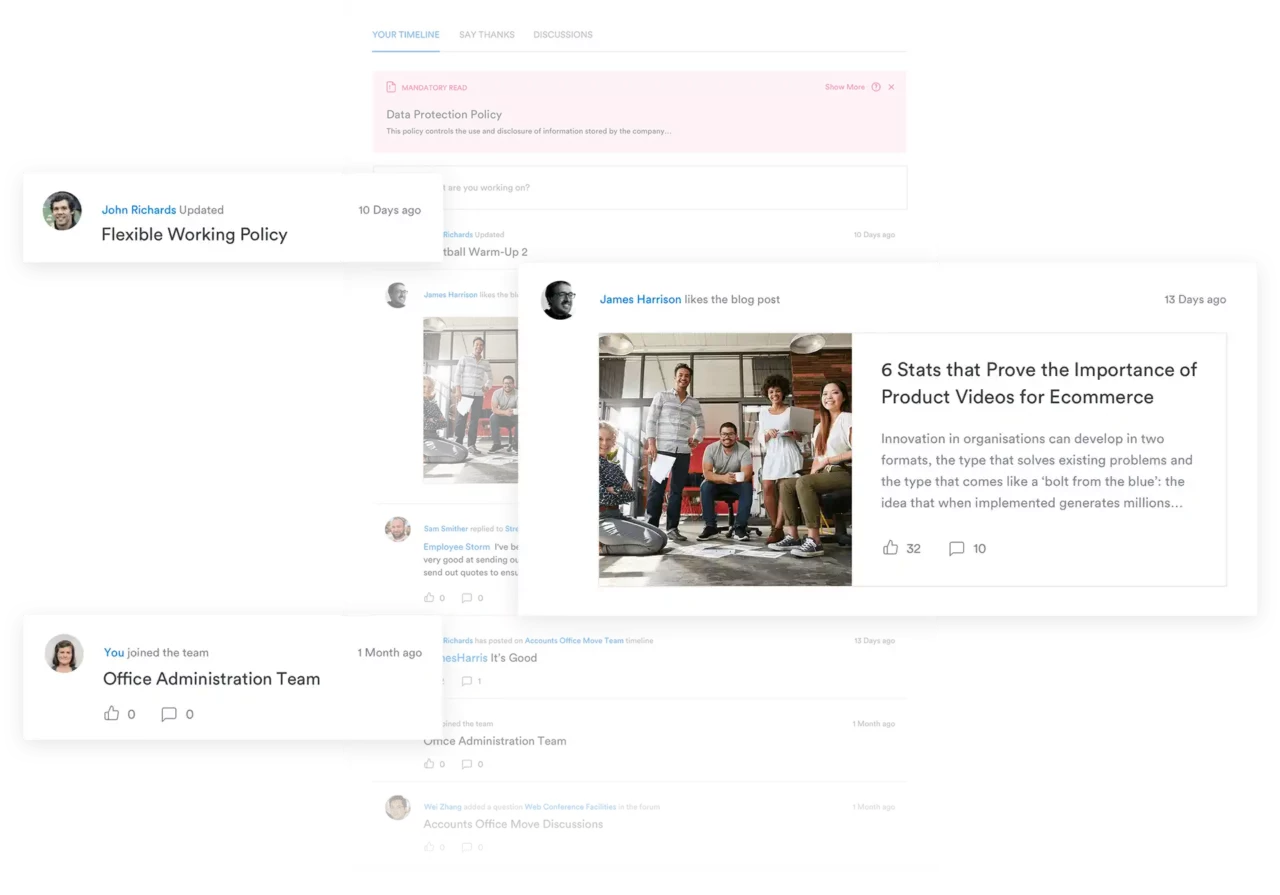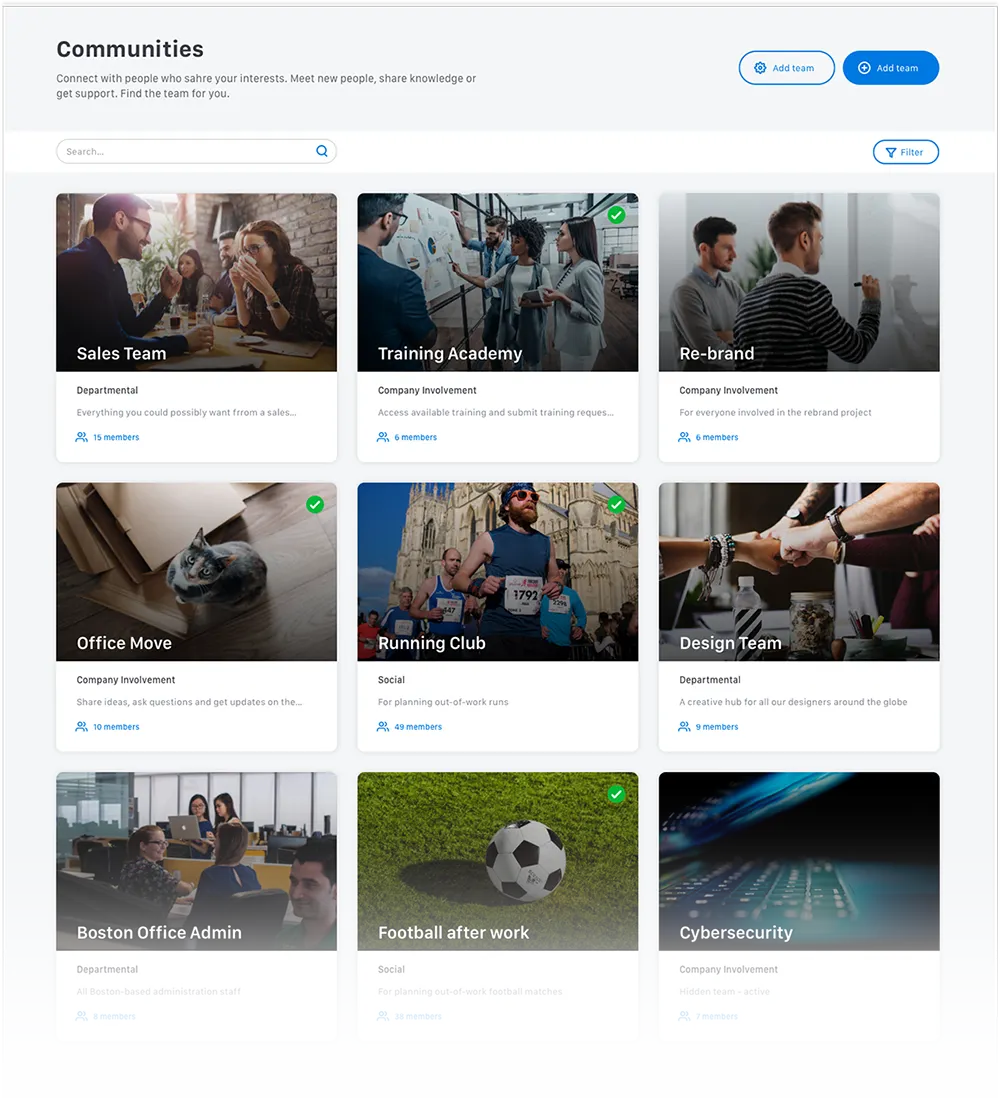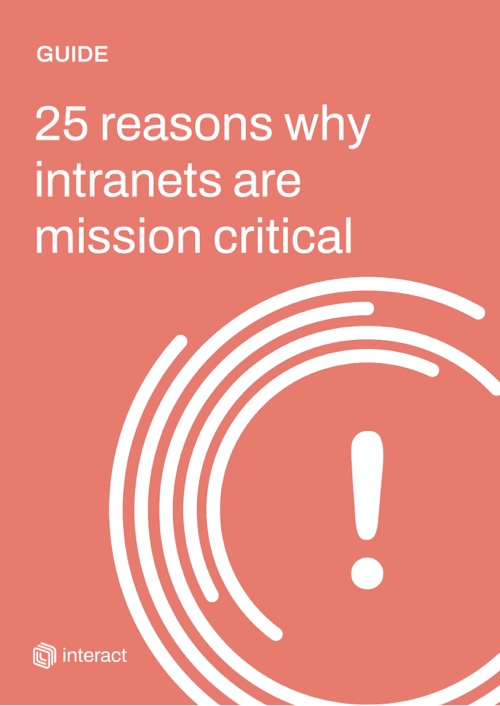Just as social media networking quickly became a dominant presence in our lives, enterprise social networking on digital platforms has become critical in workplaces. Encouraging enterprise social networking via your intranet makes internal communications more dynamic and connects employees.
This article defines enterprise social networking and shares six benefits of incorporating it into internal communications.
We also dive into the best way to build an enterprise social network in your organization.
- What is enterprise social networking?
- 6 Benefits of enterprise social networking for your comms plan
- A social digital workplace enables collaboration and problem-solving
- Enterprise social networking facilitates two-way communication
- Internal social networking helps your business gauge employee sentiment
- Strengthen your internal brand through enterprise social networking
- Online employee connection engages a dispersed workforce
- Social capabilities create a library of knowledge with user-generated content
- Why an intranet is the best choice for your enterprise social networking needs
An intranet can help solve your organization’s toughest challenges
What is enterprise social networking?
Like social media networking on Facebook, LinkedIn, or Instagram, enterprise social networking is the process of connecting and communicating digitally (and physically) with people in your workplace.
The digital part of this is enabled by specific enterprise social network tools or intranet software. Digital platforms enable employees to post work updates on a timeline, find and message colleagues, answer polls, participate in forums, blog, leave comments and “likes” on others’ content, and tag or mention coworkers in relevant posts.
The best enterprise social networking creates a digital cultural hub that promotes belonging and engagement.
As today’s workers become more dispersed and less engaged, enterprise social networking is more popular than ever. This is especially true among large organizations that want to foster connection. Introducing it at your company can forward numerous internal comms goals. This may range from getting essential information in front of employees to improving engagement and culture, boosting knowledge-sharing, and creating a strong internal brand.
6 Benefits of enterprise social networking for your comms plan
A social digital workplace enables collaboration and problem-solving
In a large organization with many departments, collaborating across teams can be a challenge. Enterprise social networking provides employees with easy access to anyone in their organization, reducing these departmental silos.
Getting to know colleagues in different areas gives employees knowledge about others’ expertise and past projects, which means they have a better idea of who to turn to for assistance, resources, or specialized knowledge in unfamiliar situations.
This is great for internal communicators because it means people will more actively share resources with peers. Think of it as going viral internally.
An intranet can help solve your organization’s toughest challenges
Enterprise social networking can also promote collaboration by offsetting the limitations of a hierarchical company structure. Encouraging all employees to communicate on an equal footing in social conversations helps form relationships at all levels, making it easier for lower-level employees to speak up or raise important questions that lead to organizational progress.
Here’s another thing; with your workforce together on a single network, problem-solving and new employee ideas arise often and organically. The process can start with a simple question, concern, or issue.
By providing a platform where employees can bring up concerns to a company-wide audience, items get the attention they need from people who can help. This could mean solving a product glitch a customer is experiencing or clearing up the language on an HR policy that’s causing confusion. Either way, social crowdsourcing leads to new ideas and unique solutions from people in every corner of your organization.

Enterprise social networking should include the creation of designated online spaces and groups for collaboration.
Specific departments, employee resource groups, or projects (such as a new product rollout) may have their own areas. Having a centralized space to share ideas, updates, and documents makes a big difference for effective collaboration.
Enterprise social networking facilitates two-way communication
Top-down internal communication is important—employees want and need to be informed about key company news and policy updates. But sometimes it can feel as though these announcements are being sent into a void, and it’s hard to tell if they’re resonating with employees.

Giving employees the ability to like, comment on, tag, and share increases engagement and amplifies messaging. And it’s not limited to interacting with existing content.
Through enterprise social networking, employees can create their own blog posts or articles. It provides them with a company-wide platform: whether that’s to share a department-level initiative, a new client acquisition, photos from a work event, a post about a personal passion or cause, or even a photo of a pet keeping them company in their home office.
Enterprise social networking gives employees a voice, which is crucial to broader company success. Research shows that employees who feel their voices are heard are 4.6 times more likely to feel empowered to perform their best work.
This type of social networking can also advance DE&I. In many workplaces, leadership and comms teams don’t reflect the diversity of the organization as a whole. By giving every employee a platform, companies gain a richer variety of content, commentary, perspectives, and ideas that wouldn’t have been brought to light otherwise. This is invaluable to any organization.
Internal social networking helps your business gauge employee sentiment
Enterprise social networking can be a valuable part of your employee listening strategy as it can help gauge employee sentiment.
One way it helps is through employees’ engagement with content. When an announcement is made via internal social networking tools, whether it’s centered around updates to HR policies, an important business milestone, or a recap of an industry event, users have the opportunity to interact with it.
Just like with traditional social media, tracking likes, comments, and shares can help pinpoint how employees are reacting and inform any adjustments you may need to make.
Employee-generated social content also provides insight into how workers are feeling.
- What questions are people asking?
- Are they bringing up the same issues over and over again without seeing any solutions?
- Has there been a drop-off in new content?
These are clues that it’s time to look closer at addressing employee satisfaction.
Polls and pulse surveys are a more concrete way enterprise social networking can help you assess employee sentiment. Regularly checking in on how people are feeling by conducting surveys in areas such as employee engagement helps highlight areas for improvement before they become bigger problems. And the format of these surveys matter, making social channels ideal. An email is easy to ignore, but a notification on a platform employees use every day will yield higher participation.
An intranet can help solve your organization’s toughest challenges
Strengthen your internal brand through enterprise social networking
Although external branding gets most of the attention, internal branding can be just as important. Internal branding turns your employees into advocates and ambassadors for your business. It increases engagement, which boosts retention, productivity, innovation at work, and other positive outcomes.
Just as traditional social networking is an external brand-building resource, enterprise social networking can facilitate a strong internal brand. It brings your company’s culture, mission, and values into employees’ daily consciousness. By spurring engagement and connection, it delivers a sense of belonging, loyalty, and pride.
This can start with onboarding. When an employee joins your organization, they’ll have a front row seat to your company culture from the start. They’ll get to know names and faces, find sources of valuable information, explore recent conversations, and even get to introduce themselves. The opportunity to jump start a sense of belonging sets new employees up for a long, successful future with your company.
Online employee connection engages a dispersed workforce
The reality of the modern digital workplace is that while you may be working with your colleagues, you’re not always working with them. Dealing with remote or hybrid work, differing time zones, and multiple office locations can be difficult in terms of connection. Casual, non-work-related conversations go a long way toward improving employee satisfaction, but they often fall by the wayside when employees are dispersed. With over half of remote workers feeling disconnected from their colleagues, this isn’t an issue to be ignored.

Enterprise social networking gives dispersed workers the feeling of being right at the organization’s cultural hub, whether they’re at home or in the office. With access to a social network, they can get up-to-the-minute internal communications, send messages to their peers, and peruse company culture content. This conversation, information, and support that these workers derive from these interactions makes an enormous difference in employee engagement.
An intranet can help solve your organization’s toughest challenges
Social capabilities create a library of knowledge with user-generated content
Internal blogging is an important part of any enterprise social networking strategy, and a surefire way to take your internal communications strategy to the next level.
By encouraging various departments to create internal blogs about events, initiatives, policy shifts, new strategies and campaigns, product features, and team achievements, internal social networking becomes a valuable resource for company information that employees can revisit for months and years to come.
Blogging keeps employees informed on a platform they check often and helps them feel connected to broader events in your organization. It also boosts cohesion through the celebration of shared wins and successes.
Why an intranet is the best choice for your enterprise social networking needs
There are two main types of internal social solutions for your business. The first is an enterprise social network, which is a dedicated platform with a purely social purpose. Employees log in for connection and conversation, but other activities are limited. Simply put, although enterprise social networks can be a useful tool, they are not typically the center of the employee experience and it is unlikely that you can optimize technology like this to incorporate additional functions.
An intranet, on the other hand, has many different functions, with social capabilities interwoven throughout. Because it already serves as the hub of a company’s digital workplace, employees are on their company’s intranet regularly. This makes them more likely to engage with and benefit from the social content there.
For example, an employee may be too overwhelmed with tasks during their onboarding period to pay much attention to an enterprise social network app. However, when their onboarding occurs on the company intranet, they’ll see social content right on their dashboard, and reap the benefits right away.
Enterprise social networking improves collaboration. This effect is even stronger when combined with an intranet’s strong foundation of information and document sharing. Intranets also have better systems for organizing and maintaining content, so posts and conversations are well-catalogued and searchable for any future needs.
Although enterprise social networks can have their benefits for some organizations, selecting an intranet solution with built-in enterprise social networking features offers the best usage, collaboration, and information sharing capabilities.


